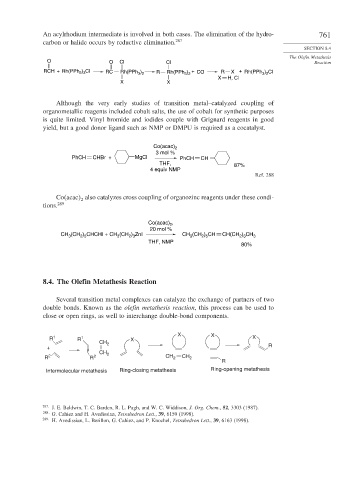Page 785 - Advanced Organic Chemistry Part B - Reactions & Synthesis
P. 785
An acylrhodium intermediate is involved in both cases. The elimination of the hydro- 761
carbon or halide occurs by reductive elimination. 287
SECTION 8.4
The Olefin Metathesis
O O Cl Cl Reaction
RCH + Rh(PPh 3 ) 3 Cl RC Rh(PPh 3 ) 2 R Rh(PPh 3 ) 2 + CO R X + Rh(PPh 3 ) 2 Cl
X H, Cl
X X
Although the very early studies of transition metal–catalyzed coupling of
organometallic reagents included cobalt salts, the use of cobalt for synthetic purposes
is quite limited. Vinyl bromide and iodides couple with Grignard reagents in good
yield, but a good donor ligand such as NMP or DMPU is required as a cocatalyst.
Co(acac) 2
3 mol %
PhCH CHBr + MgCl PhCH CH
THF, 87%
4 equiv NMP
Ref. 288
Co acac also catalyzes cross coupling of organozinc reagents under these condi-
2
tions. 289
Co(acac) ,
2
20 mol %
CH (CH ) CHCHI + CH 3 (CH ) ZnI CH (CH ) CH CH(CH ) CH 3
2 5
2 3
3
2 3
2 5
3
THF, NMP
80%
8.4. The Olefin Metathesis Reaction
Several transition metal complexes can catalyze the exchange of partners of two
double bonds. Known as the olefin metathesis reaction, this process can be used to
close or open rings, as well to interchange double-bond components.
X X
R 1 R 1 X X
CH 2
+ R
CH 2
R 2 R 2 CH 2 CH 2
R
Intermolecular metathesis Ring-closing metathesis Ring-opening metathesis
287
J. E. Baldwin, T. C. Barden, R. L. Pugh, and W. C. Widdison, J. Org. Chem., 52, 3303 (1987).
288 G. Cahiez and H. Avedissian, Tetrahedron Lett., 39, 6159 (1998).
289
H. Avedissian, L. Berillon, G. Cahiez, and P. Knochel, Tetrahedron Lett., 39, 6163 (1998).

